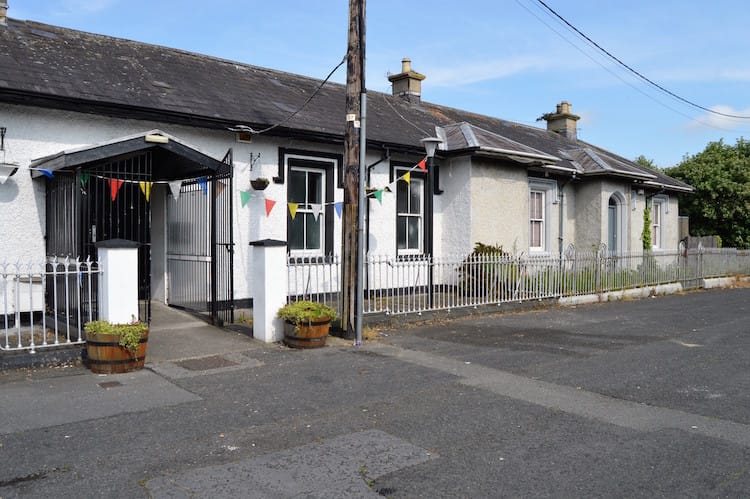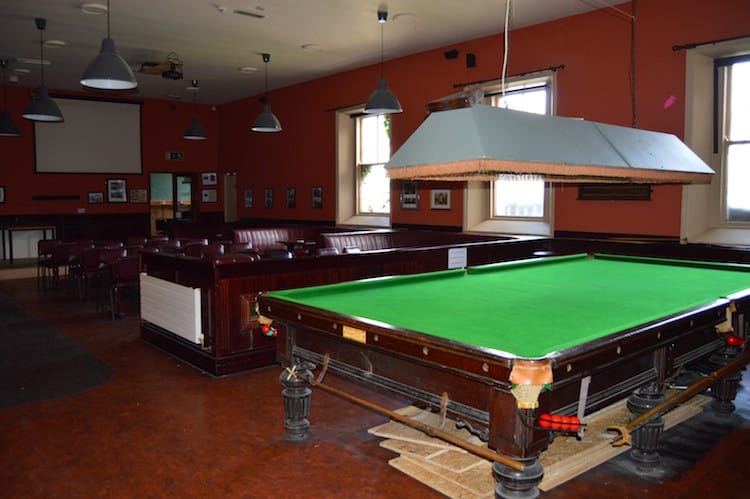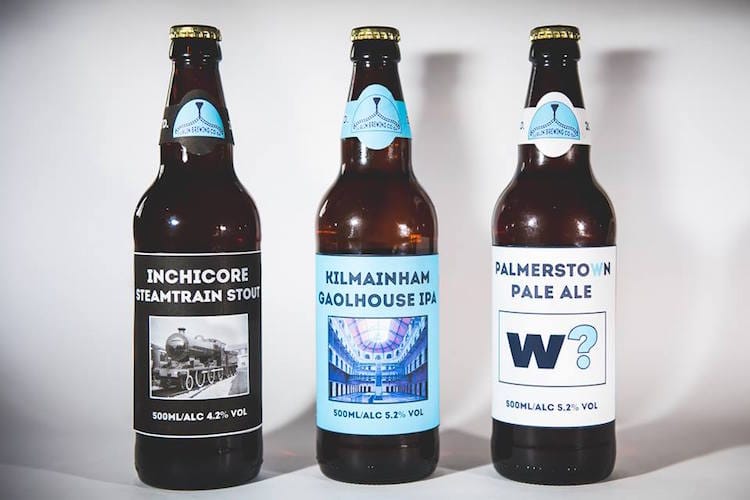What’s the best way to tell area residents about plans for a new asylum shelter nearby?
The government should tell communities directly about plans for new asylum shelters, some activists and politicians say.
Inchicore Sports and Social Club has a history that dates back to the nineteenth century, but modern times have been tough. So they’ve invited the brewers in.

The Inchicore Sports and Social Club has become a bit ragged over the years.
A ten-minute stroll from the village, in a squat nineteenth-century building that looks small from the front but is vast inside, the club has a spacious bar and a roomy lounge. There’s an event hall, a games room, and a kitchen.

But there are rips in a couple of the leather-looking seats, one glass door pane is badly cracked, and there is the distinct scent of damp. Up toward the high ceiling of the front office, there are signs of water damage on the white paint.
“As you can see it’s very damp. Leaks like a sieve,” says the club’s treasurer, Nicky Russell, as he stands in the neat office.
And because the building is a protected structure, the estimates they’ve gotten for fixing the roof are €250,000, he says.
“All we do is run up every time we find a leak and try patch it, but it just moves the leak to another spot,” he says. “We’re fighting a losing battle really.”
But a plan is in the making, and he hopes it will revive the club and the building.
It involves beer and it also involves Paul Hallissey of the Dublin Brewing CoOp, who hopes to set up in the old sewing rooms of the premises, where in times past local women would come for sewing lessons, and later, uniforms and suits were made for CIE workers.
With some money from that business and a new attraction bringing people back to the club, they might be able to do up the neglected building, he says.
Hallissey knows that the site has its issues, but is eager to team up with another co-op, and create a few jobs for people in Inchicore and Ballyfermot.
“We want that to be part of it, because it’s local, there’s the heritage, the history, and it’s about local jobs as well,” he says.

The first piece of the club’s home was built in the 1860s by Great Southern and Western Railway company, according to a Dublin City Council report. It was for the company’s workers.
Later, it grew in size as a reading room, dining hall, dispensary, and sewing rooms were added. And it continued as a social club when Córus Iompair Éireann (CIE) was established in 1945.
It has changed hands a couple of times since then, and about seven years ago, some of those living in the area took over the running the club, says Russell. “Local residents didn’t want to see the place got to pot,” he adds.
Russell, who comes in three mornings a week to do office work, came to the club for a year’s work experience in 2012 . After that he volunteered, but he didn’t intend to stay for as long as he has.
“I said I’ll volunteer until they find someone to replace me,” he chuckles. “I’m still waiting for someone to replace me and now I do bar work on Thursday evenings . . . I’ll never leave this old building.”
The club opens on Tuesdays for bingo, Thursday nights, and three Fridays in each month. Pints are cheap, so the bar doesn’t even cover costs. But raffles and events make up the rest.
“We’re keeping our head above water,” he says. “Just about!”
Russell and the committee have been trying to make sure the club is used, to help cover the bills. (The club was quoted €250,000 to re-slate the roof.) They’ve tried the regular, club-familiar ways.
The large hall is rented out for events, communions and weddings, and some of the bigger rooms have been rented to filmmakers looking for an old-fashioned bar. In the last two months, two films have shot scenes here, including Pat Shortt’s latest comedy, The Flag.
The club has roughly 220 members, with some as far away as Bohernabreena and Cabra. Some just pay the €20 membership to support the club. Most who actually drink here live locally in Inchicore or Ballyfermot.
“It’s only the same handful that use the place,” says Russell. “We need to get more life into it.”
Local independent city councillor Paul Hand says the club has been very quiet any time he’s been there. One of the problems, he says, is that it’s away from the rest of Inchicore and doesn’t get as much footfall as the other pubs in the area.
If the Dublin Brewing CoOp set up there, though, Hand thinks it could encourage people to make the extra effort to get here.
“It isn’t as widely used as it used to be,” he says. “This might put a bit of extra life into it.”
Black-and-white photos on the walls show crowded sports pitches at the back of the building and the trophies behind the bar are reminders of busier times.
When Russell is behind the bar on a Thursday night, he says the older members reminisce about years gone past, and tell him how you’d come in at seven o’clock and wouldn’t get a seat.
The pool table is in perfect condition, but is covered over. Somewhere, says Russell, there are a bunch of tennis tables hidden away too.
As he sees it, the club needs to start enticing in younger people. “I love this oul building,” he says. “I’d love to see it packed and busy again.”

Hallissey of the Dublin Brewing CoOp estimates that it would cost €50,000 to get the brewery up and running.
He’s applied for a €20,000 grant to make the project possible, and hopes to get investors involved through the Employment and Investment Incentive scheme.
The co-op’s saving some of its best kegs of beer, which it has brewed on a small scale, for beer festivals in September, because Hallissey expects investors to come along to them.
But before Hallissey can get started and apply for planning permission, the social club needs to be rezoned.
Hand, the councillor, put in a motion to the Dublin City Development plan for the building to be zoned for employment use (Z6), instead of its current zoning as an amenity or open space (Z9).
If the change doesn’t go through, Hallissey will have to wait for the next development plan to come around in six years and try again.
For now, he’s pushing ahead, planting hops in the grounds of the club to flavour the co-op’s craft beer, and starting to promote the brand.
He put together a business plan and thoroughly researched both the brewing industry and co-ops. Last year, he went to see the Mondragon Corporation in the Basque country to see how a co-op with a workforce of 75,000 operates. Then he visited Belfast, to look at the smaller model of Boundary, which is a co-operative brewery.
He is still looking for funding, around €300,000 in total, to scale up the business. But so far, the beer itself is coming along nicely.
Enthusiastic and experienced home brewers from around the city — from Drimnagh, Ballyfermot, and Lucan — have gotten involved and are trying out recipes on a small scale.
They’ve had a fair few beer tasting nights and decided they will start by distributing a Czech pilsner, an IPA, and a seasonal chocolate stout. Consistent, quality craft beer is the aim.
For an event last week, one of their experienced brewers whipped up 120 bottles of beer on Sarsfield Road in Ballyfermot. It was a mild-flavoured pale ale, though it was 6.3 percent ABV.
Hallissey hopes to create one full-time job and two part-time jobs when the brewery first opens, and he estimates that five years in, those numbers will be up to four full-time jobs and four part-time jobs.
“The idea really is to try scale up quickly and create local jobs,” he says. “We did the breakdown of costs and what we’d need to scale up. Exports would be a big part of that as well.”
The co-op plans to have its first event along with members of Social Hops in the Inchicore Sports and Social Club in the next month or two.
Both Hallissey and Russell hope it will be the first of many.
Get our latest headlines in one of them, and recommendations for things to do in Dublin in the other.